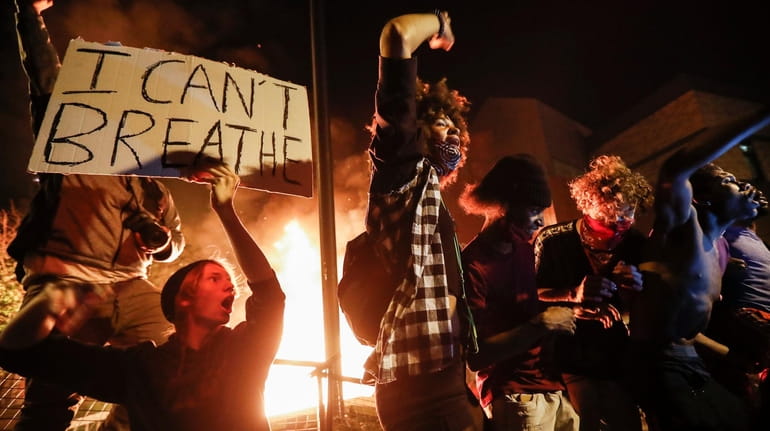Black men have a right to breathe

Protestors demonstrate outside of a burning Minneapolis 3rd Police Precinct on Thursday in Minneapolis. Protests erupted after Officer Derek Chauvin was accused of killing George Floyd, 46, with a knee to the neck after an arrest for supposedly passing a fake $20 bill in Minneapolis last week. Credit: AP/John Minchillo
Black men in the United States are always trying to tell the nation that they cannot breathe. They have been trying to tell the nation that they cannot breathe for 400 years.
They share the emotional suffocation that comes from fearing that any encounter with police can lead to violence.
They speak of the breathtaking despair of having to teach their sons complex, kowtowing strategies for avoiding conflicts with cops.
They are saying that they cannot breathe when they ask that credible accusations of misconduct against police officers and their disciplinary proceedings be made public. In New York, thanks to a law protecting cops called 50-a, they aren’t.
They are gasping that they cannot breathe when a pandemic strikes their community with unequal force, fed by unequal health care and housing and support.
They are saying that they cannot breathe when they take a knee to protest the killings of unarmed black men by police officers.
And now, in cities across the nation where clashes are growing each night — including Minneapolis, New York City and Washington, D.C. —, black men crying for the right to breathe free have been joined by allies and confronted by police officers. They've seen their cause sabotaged by people bent on destruction and violence and theft, many of whom seem to have no connection to the cause of racial justice.
Now they cannot breathe for the smoke and burning of communities where all the trauma and rage is suddenly on display.
A symbol
The phrase “I can’t breathe” became a symbol of police violence against black men when NYPD Officer Daniel Pantaleo killed Eric Garner with a chokehold for selling loose cigarettes in 2014. It found new relevance when Officer Derek Chauvin was accused of killing George Floyd, 46, with a knee to the neck after an arrest for supposedly passing a fake $20 bill in Minneapolis last week.
Floyd’s arrest and killing, captured by surveillance cameras, phones and police body cameras, is an enraging show of police brutality.
Floyd never resisted arrest. He was handcuffed early in the encounter, unable to pose any threat. The Minneapolis Police Department manual says neck restraints and chokeholds are reserved for officers in life-or-death situations. It also demands cops intervene when officers use excessive force.
Chauvin was on the scene with three other officers, two of whom held Floyd down by the legs as Chauvin drove a knee into his throat. The criminal complaint that charged Chauvin with third-degree murder said the officer held his knee on Floyd’s neck for eight minutes and 46 seconds. Two minutes and 53 seconds of that was after Floyd had become unresponsive.
Chauvin reportedly has been the subject of at least 18 Internal Affairs complaints, and received at least three official admonitions. That often seems to be a part of such stories. Supervisors and other officers know the bad cops who are dangerous, do nothing to stop them, and actively protect them.
The Minneapolis Police Department is led by a black chief, but plagued with a history of racial inequity and prejudice, which is also a familiar part of these tragedies.
Shameful moments
Long Island’s county police departments face the same shameful predicaments of institutional racism and police officers protecting each other. A 2017 Newsday investigation of arrests from 2005 to 2016 found that nonwhites on Long Island were arrested for all crimes at nearly five times the rate of whites. Studies show that whites and minorities use marijuana at about the same rates, but on Long Island nonwhites were four times as likely to be arrested for it. And both departments were embroiled in the shooting of a cabbie in Huntington Station by an off-duty Nassau County cop that saw that officer fired but left his partner, who lied about what happened, and two Suffolk officers who tried to get the cabbie to sign a false confession while he was drugged and hospitalized, on the job.
In Minneapolis, Police Chief Medaria Arradondo fired the four officers involved fairly quickly, which is progress. State and federal investigations are looking into both the killing and the fact that the visual evidence clearly contradicts the report the officers wrote. So, too, is President Donald Trump’s demand that the Department of Justice expedite its investigation, though it came in the wake of his infuriating tweet of the 1960s dog-whistle racist phrasing “when the looting starts, the shooting starts” and were followed by tone-deaf threats to protesters likely to fan the flames.
The protests are justified. The destruction and looting are counterproductive. Across the nation, police and civilians have to de-escalate the current tension and keep the focus on the underlying problems that keep killing men like Floyd, not the TVs stolen in the aftermath.
In New York, it’s time to change the law that keeps bad-cop conduct secret, and policies and cultures that keep bad cops on the job. Police officers must expose bad behavior among fellow officers.
Black men have a right to draw free and fearless breath. Every American has a responsibility to see to it that they can.
- The editorial board
